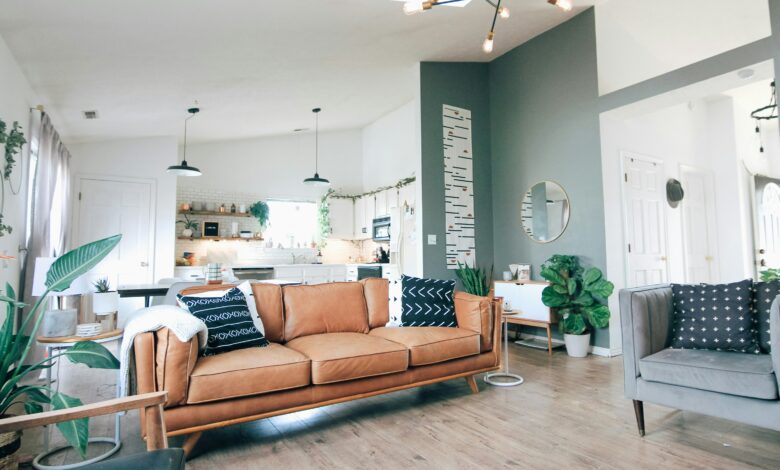Creating a Health-Conscious Living Space

Table of Content
A health-conscious living space can be defined as a home or living environment designed and maintained to promote physical, mental, and emotional well-being. This includes incorporating natural light, clean air, low-toxicity materials, and mindful design choices.
Creating a health-conscious living space has numerous benefits for individuals and families. It supports overall health and well-being and improves productivity, creativity, and overall quality of life.
Together, let’s start building a health-conscious living space by following this helpful guide. Remember, making small changes to our living spaces can greatly improve our overall health and well-being!
What Makes a Home a Health-Conscious Living Space?
When it comes to creating a health-conscious living space, there are several key factors to keep in mind. One of the most important elements is incorporating natural light and clean air. This can be achieved by choosing homes with large windows or installing skylights, as well as using air purifiers to improve indoor air quality.
In addition, opting for low-toxicity materials and mindful design choices can greatly benefit our health and well-being. Another important aspect of creating a health-conscious living space is decluttering and minimizing distractions. You may also want to explore any related sites or blog posts that can give you insights as you take your first steps in building a healthier living space.
Let’s explore more about these initiatives and learn more tips in the following sections!
Incorporating Mindful Practices into Your Living Space
By incorporating the following tips and practices into our homes, we can create a living space that promotes not only physical well-being but also mental and emotional wellness.
1. Prioritize Natural Light
Natural light plays a pivotal role in our mental and physical health. It helps regulate our body’s circadian rhythm, improving sleep patterns and mood. Exposure to natural light during the day can also increase productivity and energy levels.
To maximize natural light in your home, start with your windows. Keep them clean and unobstructed to let in as much sunlight as possible. Use light-colored, reflective curtains or blinds to bounce light into the room rather than absorb it. Mirrors strategically placed opposite windows can also help distribute light more evenly. If possible, consider installing skylights or additional windows, especially in darker areas of your home.
2. Add Air Purifying Plants
Air-purifying plants not only add a touch of nature to your home but also help improve the air quality. They absorb harmful pollutants through their leaves and roots, convert them to plant food and release clean oxygen back into the environment.
Here are some recommended air-purifying plants and their care instructions:
- Spider Plant – Known for its ability to absorb formaldehyde, a common indoor pollutant. It prefers bright, indirect light and needs watering once a week.
- Snake Plant – Effective in removing toxins like benzene and formaldehyde. It can thrive in low light conditions and requires watering every 2-3 weeks.
- Peace Lily – Helps reduce the level of mold spores. It prefers low light and must be watered when the soil is dry.
- Boston Fern – Excellent at removing formaldehyde and xylene. It thrives in high humidity and indirect light and needs consistent moisture.
3. Create a Calming Atmosphere
Stress can significantly impact our health and well-being, leading to issues like anxiety, depression, insomnia, and even certain physical ailments. Hence, creating a calming atmosphere at home is crucial.
Start by decluttering your space. A tidy, organized environment can help reduce feelings of overwhelm and anxiety. Next, consider incorporating calming elements like candles, essential oils, or indoor fountains. These can create a sense of tranquility and promote relaxation.
The color scheme of your space also plays a role in setting the mood. Choose neutral or calming colors like soft blues, greens, or greys. These shades are known to induce a sense of peace and serenity.
4. Promote Clean Air
Indoor air pollution can be a silent threat to our health. It can stem from various sources like dust, mold, chemicals from cleaning products, and even outdoor pollutants that make their way inside. Prolonged exposure can lead to respiratory issues, allergies, and other health problems.
Improving indoor air quality is therefore crucial. One effective way is to use air purifiers, which can filter out many harmful particles. Proper ventilation is also essential. Regularly open your windows to allow fresh air in and stale air out. You could also consider exhaust fans in areas like the kitchen and bathroom where moisture and odors build up.
5. Choose Low-Toxicity Materials
Traditional building materials, furniture, and decor can often contain harmful chemicals that release toxins into the air over time, a process known as off-gassing.
Low-toxicity materials can considerably reduce exposure to these harmful substances, thus promoting better indoor air quality and overall health. Opt for furniture and decor made from natural materials like solid wood, organic cotton, or wool, which typically contain fewer chemicals.
Consider using paints, adhesives, and sealants labelled as low-VOC or VOC-free. VOCs (Volatile Organic Compounds) are chemicals that vaporize at room temperature and can cause various health problems, including headaches, nausea, and damage to the liver, kidney, and central nervous system.
Conclusion
The spaces we inhabit profoundly influence our well-being. It’s more than just a place to rest or work. It’s where we cultivate health and nurture our spirits. It’s about fostering an environment that respects us and the nature we are part of. May each choice you make in crafting your space bring you closer to harmony, health, and peace. Remember, your home is an extension of you. Let it reflect who you are and who you aspire to be.




